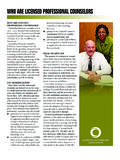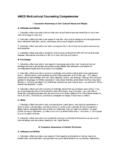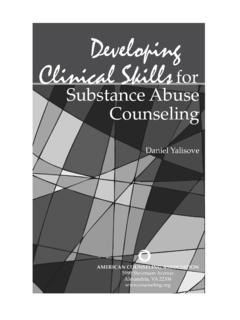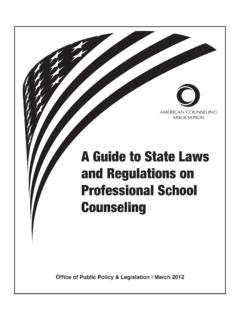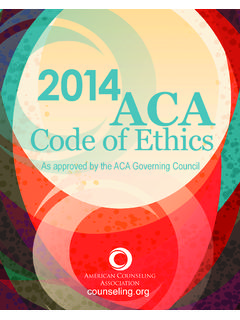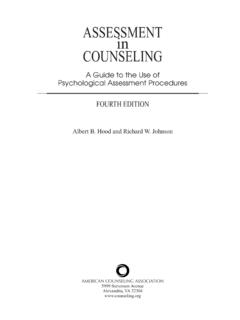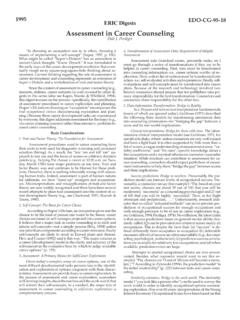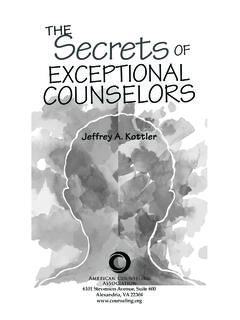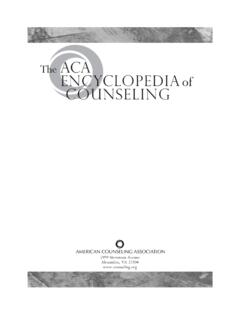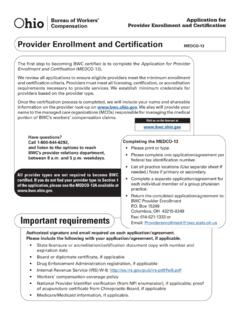Transcription of Five Out of the Box Techniques for Encouraging Teenagers ...
1 Article 3. Five Out of the Box Techniques for Encouraging Teenagers to Engage in Counseling Elisabeth D. Bennett, Kathy Le, Kevin Lindahl, Spencer Wharton, and Tin Weng Mak Bennett, Elisabeth D., is a professor and program director of Clinical Mental Health Counseling at Gonzaga University where she teaches and supervises students in master's degree training. She has been providing services to individuals, families, and couples for over 30 years and always enjoys working with adolescents. Le, Kathy, is a master of arts in Clinical Mental Health Counseling candidate. She is an intern with Frontier Behavioral Health and is focusing her training on working with both adults and youth with various diagnoses. Lindahl, Kevin, is a master of arts in Clinical Mental Health Counseling candidate.
2 He is an intern at Spokane Falls Community College and works with late-teenaged to older adult students in both an individual and group settings. Wharton, Spencer, is a master of arts in Clinical Mental Health Counseling candidate. He is an intern at Spokane Falls Community College where he works primarily with Teenagers and young adults. Mak, Tin Weng, is a recent graduate with a master of arts in Clinical Mental Health Counseling who has focused her work on counseling children and families of trauma and developmental disorder. She is now serving as a Behavioral Therapist at Discovery Counseling Group in Seattle and as an extern at Lutheran Community Services. Abstract Counseling Teenagers can be difficult when traditional talk therapy may serve as a barrier in communication.
3 A great deal of resistance may exist when working with teens because of their internal and external developmental transition from child to adult. In order to combat this, counselors must equip themselves with a variety of creative Techniques that promote both verbal and nonverbal expression in a way that is therapeutic rather than stigmatizing. This article provides five creative and developmentally appropriate Techniques for assisting counselors in increasing engagement while also allowing teenage clients to communicate their thoughts, behaviors, and feelings in a non-traditional way. Keywords: Techniques , adolescent, engagement, encouragement, creativity Ideas and Research You Can Use: VISTAS 2017. Communication serves as the basis for change in counseling.
4 Counselors need to be able to understand and utilize a client's inner resources and strengths in order to help them move towards their treatment goals (Leggett, 2009). When working with Teenagers , however, counselors may face a great deal of resistance that serves as a barrier to this crucial exchange. Beginning with the first session, engagement is one of the most significant tools that counselors can employ when working with teens who are reluctant about participating in counseling (Higham, Friedlander, Escudero, & Diamond, 2012). Engaging clients is the first step in forming a therapeutic alliance, because it allows clients' experience of therapy to be meaningful and to feel autonomous in their recovery (Eyrich-Garg, 2008; Higham et al.)
5 , 2012). The ability of the counselor to develop therapeutic alliance with the client is highly predictive of outcome and is a key predictor of client retention in therapy (Eyrich-Garg, 2008; Higham et al., 2012). However, it should not be assumed that the process of alliance building with teens emulates that of working with adults. Between dealing with the changes going on in one's own body and the social pressures put on adolescents by their classmates and society, the teenage years can be a difficult and confusing time of one's life. Teenagers are in the developmental stage of constant transformation whether it be physical (growth, sexual development), cognitive (formal operations), moral (values and spirituality), or identity (self-image and self- esteem) development (Eyrich-Garg, 2008).
6 As a result, teens often require a balance between both structure and freedom and independence and dependence in counseling (Veach & Gladding, 2007). This struggle for autonomy affects the therapeutic alliance and the way in which teens communicate with counselors, making engagement even more difficult. In order to combat these difficulties, the use of creativity in counseling with teens is encouraged. Creativity can provide venues for teen clients to fully develop and express their thoughts, behaviors, and feelings while becoming empowered (Leggett, 2009). Utley and Garza (2011) stated that because teens are in a state of transition between child and adult, creative approaches for engagement may serve as a vehicle for understanding more so than a traditional cognitive approach.
7 Developmentally, expressive interventions are more appropriate, as this population has a new capacity for thinking and feeling abstractly. Facilitating verbal and nonverbal expressions of thoughts, feelings, and behaviors in young clients can be done through the use of therapeutic interventions that are a combination of both talk and play. Veach and Gladding (2007) defined creativity as one's capacity to create a product that is original or unexpected and useful to the task at hand. Creativity then can serve as a medium of expression that is often recognized as therapeutic rather than threatening and stigmatizing, because it provides a safe distance between client and counselor in comparison to traditional talk therapy (Slyter, 2012.)
8 Utley & Garza, 2011). The goal is to use creativity when working with teens to encourage freely associated and uncensored communication (Kelly, 1972). To do so, the counselor needs to be on top of the current and historic knowledge not only regarding adolescent development but also regarding current adolescent trends, interests, struggles, and venues for connection. To that end, the authors offer the following brief review. 2. Ideas and Research You Can Use: VISTAS 2017. Issues Pertinent to Counseling Teens and Scenarios of Disengagement Over 20% of American teens experience mental illness that causes them severe impairment and/or distress (Merikangas et al., 2010). Data from the National Survey on Drug Use and Health (Center for Behavioral Health Statistics and Quality, 2015).
9 Suggested this rate of prevalence is slightly higher than that for adults with any mental illness ( ) and dramatically higher than adults with serious mental illness ( ). Several mental illnesses tend to have onset in adolescence (Kessler et al., 2007), and adolescents without diagnosed mental illnesses are still likely to encounter extra stress in this transitional period of their lives (Niwa et al., 2016). These psychological stressors are reflected in the suicide rate: suicide was the second leading cause of death among adolescents age 15 19 in 2014, second only to unintentional injury (Centers for Disease Control and Prevention, National Center for Injury Prevention and Control, 2016). These statistics paint a picture of a period of turmoil, an understanding underscored by several developmental perspectives.
10 Erikson (1964) posited that the key conflict at this stage of psychosocial development was identity versus role confusion; in this period, adolescents are facing the existential task of determining who they are and how they want to live. At this stage, Teenagers often begin to push away from their parents and authoritative adult figures in an attempt to define their own independent identity (Santrock, 2015, p. 378). However, as grown-up as they may feel, adolescents are still in the process of development. The prefrontal cortex continues to grow well beyond this period (Giedd et al., 1999; Konrad, Firk, & Uhlhaas, 2013), so Teenagers may still struggle to exercise executive functions such as forethought or emotional regulation.
